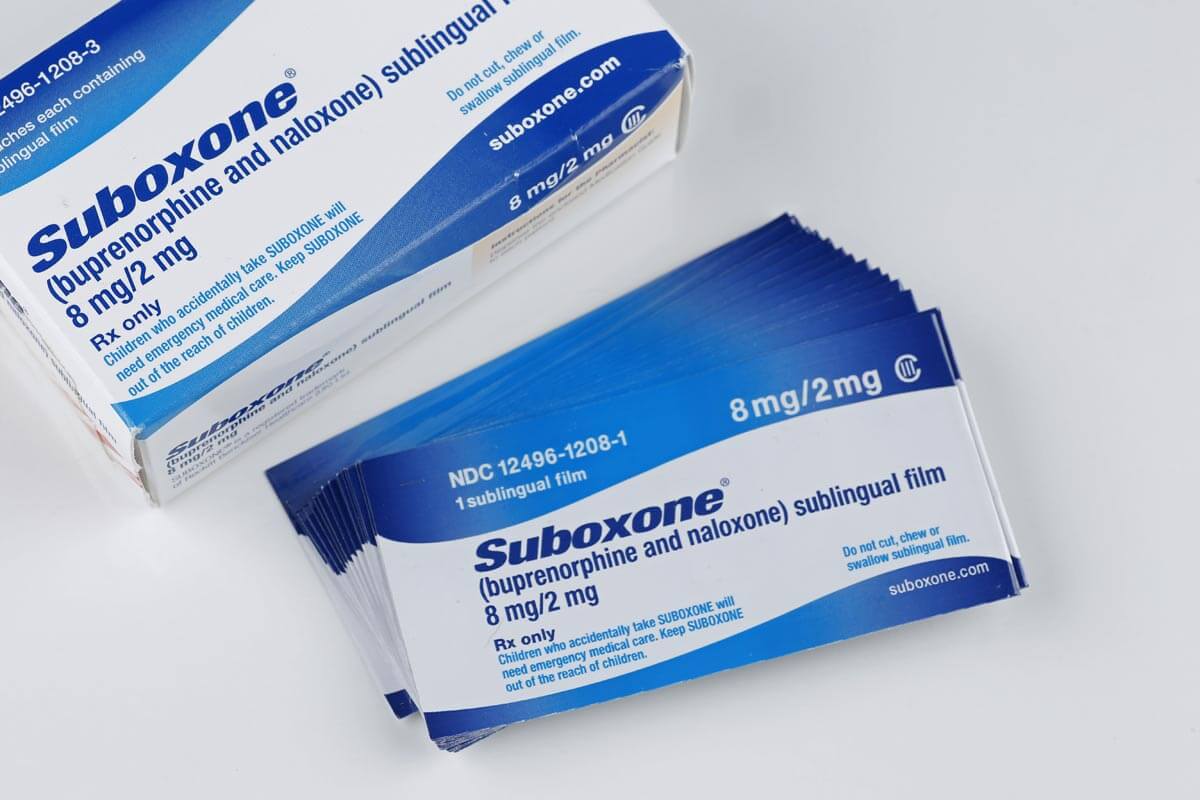 Suboxone, an FDA approved combination of buprenorphine and naloxone, is an orally administrated medication-assisted treatment drug used to treat opioid addiction. Because studies show that Suboxone and variations such as Sublocade can greatly improve outcomes in opioid use disorder treatment, Suboxone is increasingly adopted and used by treatment facilities across the United States. This is important, as opioid addiction is one of the most common and most dangerous substance use disorders in the United States. Opioids are responsible for an estimated 68% of all overdose related deaths, and medication assisted treatment solutions such as Suboxone help patients to reduce risks, reduce illicit substance use, and to improve recovery.
Suboxone, an FDA approved combination of buprenorphine and naloxone, is an orally administrated medication-assisted treatment drug used to treat opioid addiction. Because studies show that Suboxone and variations such as Sublocade can greatly improve outcomes in opioid use disorder treatment, Suboxone is increasingly adopted and used by treatment facilities across the United States. This is important, as opioid addiction is one of the most common and most dangerous substance use disorders in the United States. Opioids are responsible for an estimated 68% of all overdose related deaths, and medication assisted treatment solutions such as Suboxone help patients to reduce risks, reduce illicit substance use, and to improve recovery.
Suboxone is used to help save lives, to help patients reach a stable situation in which they can recover, and to reduce risks of relapse during treatment. If you or a loved one is considering seeking a medication assisted treatment for opioid abuse, you should know about the drug, understand how it’s used, and understand how it impacts you over the short and long-term.
What is Suboxone?
Suboxone is a combination of buprenorphine and naloxone, typically administered as a film taken under the tongue.
Buprenorphine – Buprenorphine is an opioid agonist which interacts with the opioid receptors in the brain. Unlike most other opioids, buprenorphine has a reduced abuse profile because it does not cause euphoria or sedation in light doses. Instead it binds with the opioid receptors, preventing additional opioid action and blocking most euphoric effects of other opioids. In addition, buprenorphine prevents withdrawal symptoms and cravings, because users are still taking the drug they are dependent on. However, Buprenorphine is an opioid and it can be abused. Individuals who snort or inject the drug do experience a high. Suboxone circumvents this by integrating Naloxone.
Naloxone – Naloxone is an opioid antagonist, meaning that it blocks opioids from binding with receptors. Naloxone is Suboxone’s secondary component because it is poorly digested through oral administration, meaning that it doesn’t take effect until the user attempts to abuse the drug by either taking too much, snorting, or injecting it. Users who attempt to abuse Suboxone typically go into withdrawal, which may cause unpleasant side effects or necessitate hospitalization.
Effects of Suboxone
Suboxone binds with the opiate receptors in the brain and along the central nervous system, lasting up to 3 days after the final dose. It causes both short and long-term side effects, most of which align with regular opioid usage.
Short-Term Effects – Individuals taking suboxone will typically experience immediate side effects which can range from almost non-existent to severe. However, most individuals taking Suboxone as-prescribed will experience little-to-no noticeable side effects. When taken in larger doses or for some individuals, side effects include pain relief and mild euphoria (in individuals not dependent on an opioid), fatigue, confusion, lethargy, nausea, and potential respiratory depression.
Long-Term Effects – Suboxone is typically prescribed for the long-term, with the average treatment at around 12 months. Most patients will eventually experience side effects. These include cold and flu symptoms, low blood pressure, stomach pain, constipation, nausea, and potentially vomiting. Some users will experience confusion, hallucinations, and seizures. If so, it is important to contact a medical professional right away. Most side effects only become severe in the case of suboxone abuse or taking a very high dose.
Get Your Questions Answered Now.
Suboxone in Medication Assisted Treatment
Suboxone is one of the most-recommended drugs for medication assisted treatment (MAT). Suboxone is popular because it is difficult to abuse, can be taken at home without supervision, and greatly improved outcomes. This is important for patients because it reduces time-investment and costs associated with medication assisted treatment. It also allows individuals more freedom, because they do not have to go into a doctor’s office or clinic every day for a treatment.
 Is Suboxone Effective in Treating Opioid Use Disorders? – Most clinical research points to the fact that Suboxone can greatly improve the outcomes of addiction treatment programs. However, suboxone on its own is not a treatment and it is not a cure for a substance use disorder. Individuals who simply follow a medication assisted treatment program and then stop are significantly likely to relapse once they stop. The Centers for Disease Control (CDC), World Health Organization, SAMHSA, and NIDA each recommend that Suboxone be administered alongside an addiction treatment program including counseling and behavioral therapy. This is required by law in the United States.
Is Suboxone Effective in Treating Opioid Use Disorders? – Most clinical research points to the fact that Suboxone can greatly improve the outcomes of addiction treatment programs. However, suboxone on its own is not a treatment and it is not a cure for a substance use disorder. Individuals who simply follow a medication assisted treatment program and then stop are significantly likely to relapse once they stop. The Centers for Disease Control (CDC), World Health Organization, SAMHSA, and NIDA each recommend that Suboxone be administered alongside an addiction treatment program including counseling and behavioral therapy. This is required by law in the United States.
This means that there is no legal program offering Suboxone-only addiction treatment in the United States. Instead, Suboxone and similar drugs are used as part of holistic treatment programs, where Suboxone functions to help patients get to a place of mental and physical stability where they can be receptive to treatment. It ensures individuals are safe, unlikely to be at high risk of overdose, and unlikely to continue causing themselves physical, fiscal, or emotional harm because of drug abuse. In addition, Suboxone administration reduces and possibly eliminates seeking and risk-taking behaviors associated with substance use addiction, which can significantly improve the lives of patients while they seek out behavioral therapy.
In short, Suboxone is not effective in treating opioid use disorder on its own. Instead, it greatly enhances the effectiveness of other treatment methods, such as counseling and behavioral therapy.
What’s the Controversy Surrounding Suboxone?
Suboxone usage is still somewhat controversial in the United States thanks to misconceptions and stigma. Many people consider that Suboxone is an opioid and using it to recover from an opioid addiction is simply “swapping one drug for another”. This is true in a way, but the replacement drug does not cause a high, does not cause seeking behavior, and actively works to reduce the associated risks of drug abuse and addiction. Suboxone programs are associated with decreased deaths, decreased overdoses, and a decreased cost of treatment per patient, benefiting the patient, the facility, and taxpayer investments.
Other controversies link to the potential for abuse and overdose. Buprenorphine is dependence forming. Individuals must carefully follow their prescription to avoid these problems. In addition, individuals taking suboxone are at increased risk of overdose should they relapse. Buprenorphine is typically administered at a significantly lower dose than most users would take for a recreational high. This means that someone who is on buprenorphine for a long time will have a significantly reduced drug tolerance. If they take their previous dose of opioids, their risk of overdose is high.
Finally, many people think of medication assisted programs as “taking the easy way out”. This perspective is understandable considering the long history of misconceptions relating to substance use, like the idea that withdrawal provides incentive to not use again. But opioid withdrawal phases can be dangerous and traumatic and some cause irreversible neural damage. Reducing risks using a substance like Suboxone is clearly healthier and safer for the long-term.
Seeking Out Medication Assisted Treatment
 Getting help for an opioid use disorder means seeking out a treatment facility. You can consult with your doctor as well as a physician specializing in addition therapy and treatment or medication when deciding how and where you want to seek treatment. Here, you should discuss your medical history, history of substance abuse, history of drug addiction treatment, health, and mental health. Your doctor will help you choose a treatment method that best fits your needs.
Getting help for an opioid use disorder means seeking out a treatment facility. You can consult with your doctor as well as a physician specializing in addition therapy and treatment or medication when deciding how and where you want to seek treatment. Here, you should discuss your medical history, history of substance abuse, history of drug addiction treatment, health, and mental health. Your doctor will help you choose a treatment method that best fits your needs.
Attending a medication assisted treatment program involves medical and pharmacological assessments to determine drug dosing and reactions. You will also receive ongoing medical monitoring to ensure that dosing remains correct and safe. Medication assisted treatment programs, including Suboxone, are designed to supplement and improve outcomes for traditional treatment including behavioral therapy and counseling. For this reason, it’s also important to review programs offered by your rehabilitation facility, including behavioral therapy options, complementary therapy options, and staff on-hand to offer support.
Suboxone is one tool used to help individuals reach a safe and stable place to recover from. It’s one part of a comprehensive treatment program, designed to tackle every aspect of addiction, so you can recover and get back to your life.
If you or your loved-one is seeking help for substance addiction, call us at (714) 400-2048 and look into our recovery programs. Our Drug and Alcohol Treatment Center in Huntington Beach helps clients by providing them with addiction intervention services, detox, and residential addiction treatment.
Other Articles you might be interested in:
Understanding Detox in Orange County
Detoxification, or detox, is the initial phase of recovery from...
Understanding Signs of Addiction with Broadway Treatment Center
Recognizing the signs of addiction is crucial for early...
How to Overcome Addiction
Overcoming addiction is a transformative journey that requires a...



